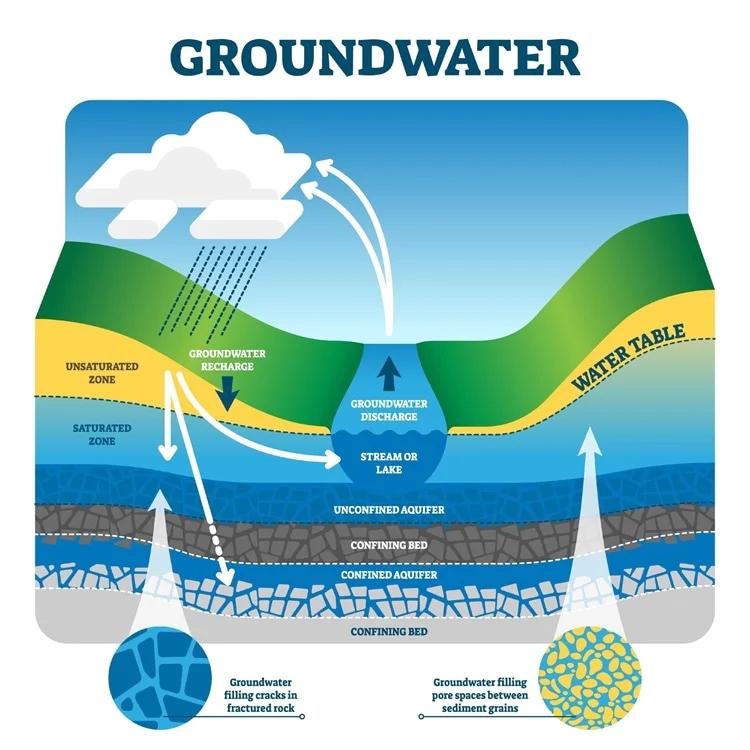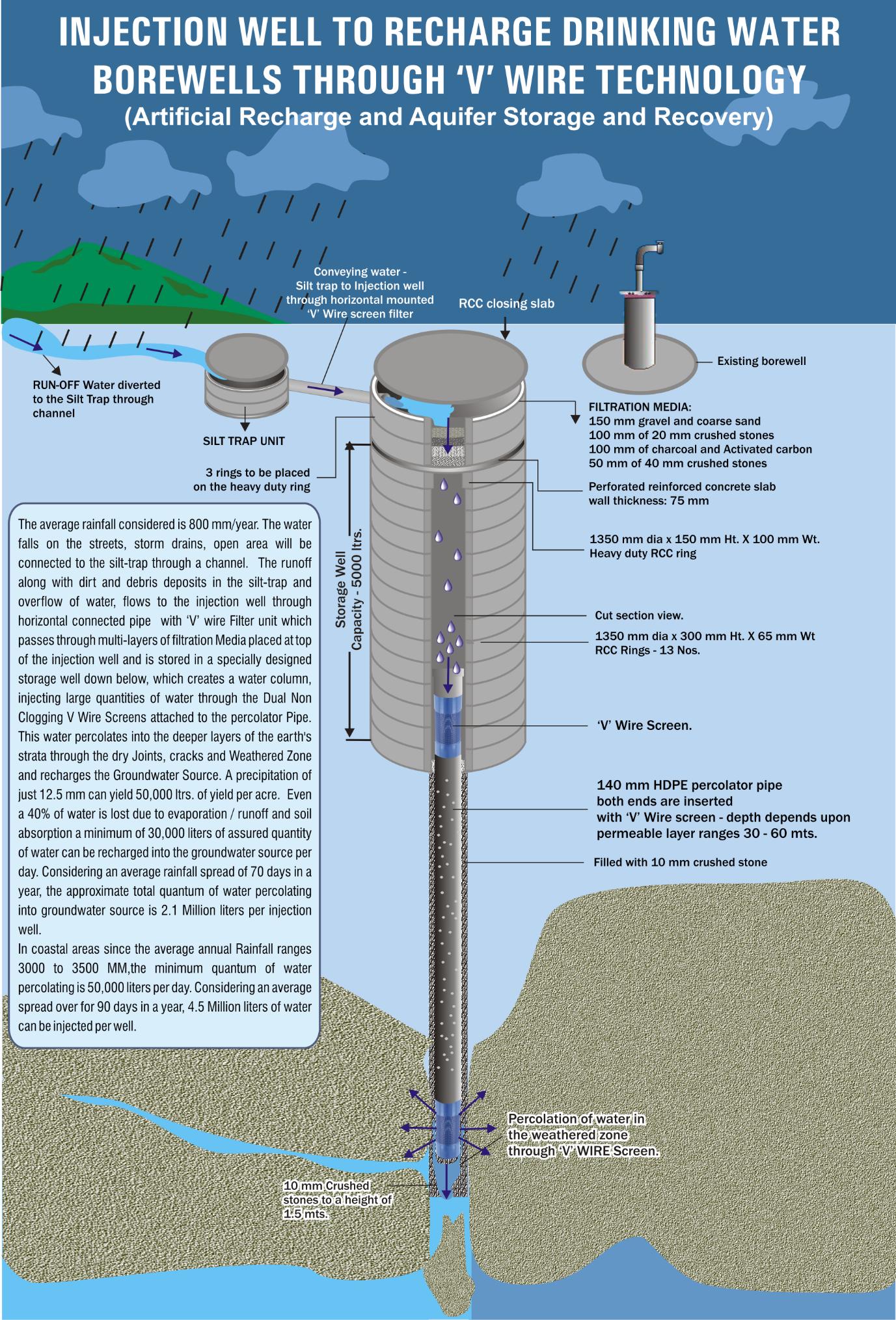Groundwater Recharge
In recent years, there is a raised concern about meeting our own needs without compromising the ability of future generations to meet their own needs. There comes a demand for water consumption to fulfil increasing residential and irrigation demands. Nevertheless, with the help rainwater harvesting techniques there comes the chance to make it possible to maintain and increase the levels of depleting groundwater resources.
Ground water recharge methods
Groundwater recharge is a process, where water seeps down from the surface of the earth and gets collected in aquifers. So, the process is also known as deep percolation or recharging the ground water table.
Groundwater recharge happens in two ways:
- Direct Recharge
- Indirect recharge
Direct recharge: Water addedby directly in vertical percolation to the groundwater reservoir in excess of soil moisture and evapotranspiration deficits. Such as surface spreading like flooding, basins or percolation tank, stream augmentation, ditch and furrow system. In sub surface like recharge well, recharge pit/shaft, dug well.
Indirect recharge: Results from percolation to the water table following runoff and localization in joints, as ponding in low lying areas and lakes, or through beds of surface water courses. Such as induced recharge.
Natural recharge happens as rain falls on the land surface, infiltrates into soils, and moves through pore spaces down to the water table. Natural recharge also can take place as surface-water leakage from rivers, streams, lakes, and wetlands.
- 1. Through rain or snowmelt
- 2. Rivers and lakes
- 3. Depression focused recharge

Artificial recharge options such as recharge ponds and injection wells, Recharge ponds allow water to slowly infiltrate through the soil into the aquifer under the ground. Injection wells use artificial pressure that is created from the water column to push the water into the ground.
- 1.Surface infiltration systems
- 2.Well injection systems
Natural groundwater recharge
- 1. Through rain and snow melt:
Water from the melting of snow and rain can directly fill the aquifer from the areas having high altitudes through openings to the unconfined aquifer.
- 2. Rivers and lakes:
Percolation of water from rivers and lake also marginally contribute to recharge the underground water.
- 3. Wetlands:
Wetland is an area where a number of aquatic plants and other species thrivewater.Soil present in the edges of the wetland contributes mainly to ground water recharge.
- 4. Depression focused recharge:
The amount of water the soil can hold after the excess water from rainfall is drained out.If the water present on the ground doesn’t exceed the field capacity of the area, then a little amount of water infiltrates into the ground.
It exceeds the field capacity when the water collected in low lying areas, and percolates through the ground surface recharging the aquifer.
Artificial groundwater recharge
- 1. Surface infiltration system
The surface infiltration system is a method of spreading the water which is excess on the surface and makethe water to seep into the ground. This technique is possible in areas where the soil is permeable to allow water to pass through it.
a. In-channel systems: In-channel systems function by spreading the water over a larger area making it easier for infiltration process using dams, L or T-shaped levees and small-size weirs.
b. Off-channel systems: Off-channel systems has gravel-pits and infiltration basins.
There are two ways
Another way to fill aquifers through deep dug wells also known as recharge wells.
Artificial point source groundwater recharge is beyond the water percolating method or inject deep into the earth. This undergoes a treatment process by changing its composition while infiltrating down to the ground.
The water is being pre-treated before directed into the ground. Considering surface runoff rainwater is taken for the recharge process. After that the water undergoes post-treatment via aquifer layers, and this process is also known as Soil Aquifer Treatment(SAT).
An example for artificial Injection Well groundwater recharge is ‘V’ wire technology method.
Groundwater rechargingmost effective in holding surface run off water both from plain open loose area. This is done using V-Wire Injection Well Technology. This is a modern technique which uses V-Wire Screens for filtration. This system works on gravitational force that does not require any energy, making it durable with a long-life span.
The strategic points for drilling injection wells are identified via geo-physical survey. Fracture zones, cracks and joints present in the permeable zone have remarkable ability to store water.
There are four stages of filtration through Silt Trap and Injection well. The silt traps: most impuritiesget trapped in the first stage itself. And the water flows through the horizontally fixed V wire non clogging SS screen. Water then passes through multi layered filtration media and gets stored and creates a water column. Rainwater then flows through main Injection well where and recharge groundwater table.
This ‘v’ wire injection well technology can also be adopted next to existing borewell to increase the yield redundancy.
Great technology to ensure rapid recharge of ground water and recover the water levels in the Aquifer.

1. Ensure long-term groundwater by raising groundwater levels.
2. Artificial groundwater recharge does not require construction of large structures such as dam to store huge amount of water.
3. The water stored in artificial recharge system is free of contamination.
4. When there is an adequate groundwater, maintains the moisture in the soil that increases vegetative cover. Which reduces erosion of soil and contributes to improve flora and fauna.
5. Enhances the maintenance of wetland ecosystems by limiting saltwater.
6. Prevents evaporation losses.
7. This stores water for future use especially during drought.
8. Artificial recharge also enhances the quality of water in saline aquifers, which can be used for agriculture and cattle farms near the coastline.
9. Less energy will be required to pump the same amount of water by artificial recharge. As a solution for net savings in energy demands like energy required by the recharge operation.
10. Increased groundwater storage due to artificial recharge allows surface water sources to flow for extended periods, and seasonal streams may acquire perennial flow in some localities.
11. Serves as storage of rainwater, which will be useful at the time of water scarcity.
12. In coastal areas this is prevention for the intrusion of sea water into the aquifer.
13. Maintaining base flows in streams.
14. Reduces the costs of pumping of ground water levels, due to lowered depth of ground water level.
Benefits
Future of water
1. Groundwater resource must be carefully protected and limited from irrational use and pollution.
2. Ground water recharge can support lives in a wide range of physical social and economic factors of the environment.
3. Artificial groundwater recharge is a significant measure apart from time that nature takes to fill up the ground water table by absorbing and filtering surface water.
4. Protecting groundwater is one of the main problems in the planet earth which also contributes in protecting the natural environment.
5. The water conservation measures would be the future of water with an all-time demand for water.
6. Ground water recharge is a key or a way-out measure, which fill up aquifers.
7. Including the upstream and downstream userscould work together to maintain a healthy water cycle through “forest protection, reforestation, and improved agricultural practices.”
8. Groundwater recharge allows compensating or rather offsetting the negative impacts of unsustainable water use.
Importance of Groundwater recharge
1. Aquifer depletion happens with the withdrawal of ground water for drinking, irrigation, industrial and other human uses than is naturally replaced.
2. Lower groundwater level affects agricultural and municipal water usage.
3. Recharge of ground water table can help reverse the cycle.
4. Removal of water from the soil, the land may drop as the soil compacts and cannot support the land above.
5. The usage of water for agricultural purpose contributes up to 50 billion gallons of groundwater on daily basis.
6. Over utilization of waterwould result in dry wells, lack of water quality.
7. In water cycle, groundwater recharge would take place through precipitation and natural replenishment. This happens when there is a natural equilibrium. At the present-day situation, this might not the case.Climate change drastically alter the water cycle, causing reduced precipitation than normal.
8.Lower water table brings a condition that wells need to be drilled deeper.
9. While population growth and increased food demand push agricultural sector to draw more water out of the ground which is known as water stress.
10. Surface water and groundwater interact in complex ways. The effects of groundwater depletion narrow down water in lakes and streamsand decrease in groundwater levelreduces water flows into wetlands and other ecosystems which rely on it. Which leads to less vegetation and diminished water quality.


